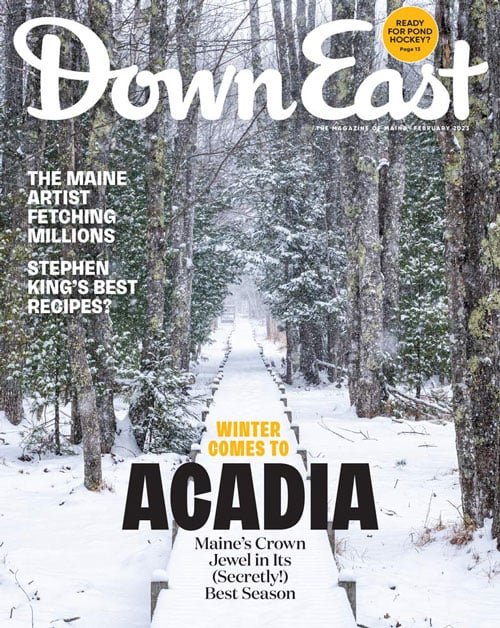“Bearing witness to the end of a once-thriving saltwater farm is a sad undertaking, yet sometimes one can do little but observe,” Peter Ralston has written about the image he calls Going By.
By Phillip Conklin
From the February 2023 Issue
There is a self-consciousness about islandness among islanders. I call it cellarhole melancholy. This is a generalized sense of loss, of what could have been, of what probably happened that shouldn’t have, of the blood, sweat, and tears that permeates every foot of island rock, soil, and beach. — George Putz, of Vinalhaven, “On Islanders,” 1984
I was reminded recently of the quote above, from my late, great friend George Putz, and then of my own acute experience of that sensation as I first felt it — and as it has similarly been felt by others who wander abandoned farmsteads and remote islands. In such places, one begins to recognize how many generations of people have clung to life in Maine and left their ghostly reminders written in the earth.
I had one such moment of realization years ago, while spending a rugged day and a half scouring the craggy shoreline of a 175-acre island off the Washington County coast, then following several transects across the island’s dense and rocky interior. I was there to conduct an ecological inventory of this remote and beautiful place, which had been given to the Maine chapter of the Nature Conservancy in the late 1960s and was first inventoried for the organization, by me, in 1975. I had documented one rare Arctic plant station and thought there might be more, so I needed to complete one last transect. Halfway across the island, I crawled out from some underbrush and stood up to find a pile of foundation stones at my feet. I was thunderstruck by the reality that someone had once lived here — on this remote, mostly desolate, half-terrifying rock in the ocean. Who were they? Had it been a godforsaken hermit? Had a family once lived here? What had happened?
When I got ashore, I asked around and at the town office, but no one seemed to know who had lived out there. Then, years later, through a serendipitous conversation with a woman from a local family, I got an indirect suggestion that I might read the 1957 novel The Edge of Darkness, by the celebrated Maine novelist Mary Ellen Chase, that the story had been a fictionalized account of the fisherman who’d once lived on that island. I found the book at the library, and several others of Chase’s, alongside the novels of mid-century bestseller Ruth Moore. Both authors’ works are haunted by the decades of depopulation that characterized many rural Maine towns throughout the 19th and 20th centuries. Island communities in particular suffered abandonment and decline — 15 Maine islands currently host year-round populations, down from some 300 a century ago. Though parts of Maine may feel increasingly crowded today, the shadow of loss still haunts our islands, woodlands, and memories.
One suggestion of a rural-population rebound in recent years has been the revival of some long-abandoned farms, often worked by young people “from away,” who have formed the backbone of Maine’s agricultural renaissance. The proliferation of farmers’ markets, local-produce sections in grocery stores, and farm-to-table events is a reminder of the endurance of a land ethic in Maine, one that respects the landscape of old souls who have lived and worked the land and sea before us.




